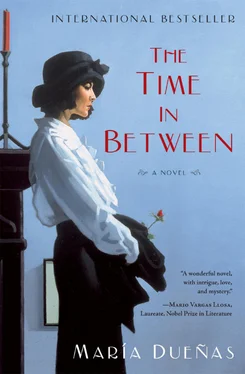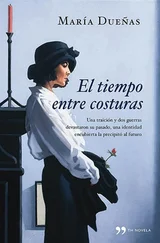“I’d like a copy of this,” she said, taking something that looked like a rolled tube of blood-colored fabric out of a small box. She laughed at our expressions of astonishment. “This, ladies, is a Delphos, a unique dress. It’s a creation of the artist Fortuny: they make them in Venice, and they’re only sold in a few extremely select establishments in the great European cities. Look what a wonder of color, look at the pleating. Their creator keeps the techniques used to make them absolutely secret. It fits like a glove. And I, my dear Doña Manuela, want one. Fake, of course.”
She took one end of the fabric between her fingers and as if by magic a dress appeared, of red satin, sumptuous and stunning, that reached down to the floor, hanging impeccably and ending round and open at the bottom; a bullring end, that’s what we used to call that kind of finish. It was a sort of tunic covered with thousands of tiny vertical pleats. Classic, simple, exquisite. Four or five years had passed since that day, but my memory had retained intact the whole process of producing that dress because I had participated in every part of it. From Elena Barea to Rosalinda Fox, the technique would be the same; the only problem, however, was that we barely had any time and I’d have to work at the pace of a demon. Helped throughout by Jamila, I heated pans of water that, once boiled, we tipped into the bathtub. Scalding my hands, I lowered the material into it and left it to soak. The bathroom filled with steam as we nervously watched the experiment, drops of sweat forming on our foreheads and the condensation making our reflections in the mirror disappear. After a while I decided it would be all right to remove the material, which was now dark and unrecognizable. We drained out the water, and each taking an end, we twisted the strip as hard as we could, turning it lengthways in opposite directions as we’d done so many times with the sheets in the boardinghouse on La Luneta to get the last drop of water out of them before stretching them out in the sun. Except that this time we weren’t going to stretch the piece of material out to its full extent but rather the exact opposite: the aim was to keep it as tightly squeezed as possible while drying so that once all the humidity had gone, the silk fabric would be transformed into a wrinkled object retaining as many pleats as possible. Then we put the twisted material in a basin and carried it between us up to the roof. We turned the ends of the fabric in opposite directions again until it looked like a thick rope that twisted in on itself in the shape of a big spring. Next we laid out a towel and placed upon it, like a coiled snake, the object that just a few hours later would become the gown in which my English client would make her first public appearance on the arm of the enigmatic man of her life.
After we left the fabric to dry in the sun, we went back down to the apartment and filled the stove with coal until we got it working at full power and the kitchen felt like a boiler room. When we calculated that the afternoon sun was beginning to wane, we went back up to the roof and retrieved the twisted material. We stretched out a new towel on the cast iron of the stove and on top of it placed the still-rolled fabric, circled onto itself. Every ten minutes—without ever stretching it out—we turned it over so that the heat from the coals would dry it evenly. Between trips to the kitchen I constructed a belt consisting of a simple layer of lining with a plain thick band of pressed silk, made from the bit of material that hadn’t been used. At five in the afternoon I recovered the twisted fabric from the iron surface and brought it into the workshop. It was like a hot blood sausage: no one could have imagined what I was expecting to do with it in little over an hour.
I stretched it out over the cutting table, and bit by bit, taking the greatest care, I undid the strange creation. And magically—before my very eyes—the silk emerged, pleated and dazzling, beautiful. We hadn’t managed permanent pleats like those on the genuine Fortuny model because we didn’t have the means and we did not know the technique for it, but we’d been able to obtain a similar effect that would last the night at least: a special night for a woman in need of something spectacular. I unfolded the fabric to its full size and left it to cool. Then I cut it into four pieces with which I constructed a kind of narrow cylindrical sheath that would adapt itself to the body like a second skin. I fashioned a simple round neckline and worked the openings for the arms. Without the time for any ornamental flourishes, the fake Delphos was finished in the allotted time: a rushed, homemade version of a model that had revolutionized haute couture. It was an imitation but one with the potential to have an effect on anyone feasting his eyes on the body displaying it.
I was trying out the effect of the belt when the doorbell rang. It was only then that I realized how pitiful my appearance had become. The sweat from the boiling water had messed up my makeup and my thick hair; the heat, the strain of twisting the material, going up and down the stairs to the roof, and all the nonstop work of the afternoon had left me looking as though the whole cavalry of the Indigenous Regular Forces had just galloped over me. I ran to my room while Jamila went to open the door; I changed clothes at full speed, combed my hair, got myself together. The result of the work had been satisfactory, and I needed at least to look up to scratch.
I went out to meet Rosalinda, expecting to find her waiting for me in the living room, but when I passed the door to the workshop I saw her standing at the mannequin. She had her back to me; I couldn’t make out her face. From the door I asked her simply, “Do you like it?”
She turned at once and didn’t reply. She came nimbly to my side, took my hand, and squeezed it hard.
“Thank you, thank you, un millón de thank-yous.”
She had her hair back in a chignon, her natural waves a little more noticeable than usual. Her eyes and cheekbones were discreetly made up; the lipstick on her mouth, however, was much more spectacular. Her high-heeled sandals raised her almost three inches above her natural height. A couple of shining white-gold earrings, broad and stunning, were her only embellishment, and she wore a delicious-smelling perfume. As soon as she had removed her street wear, I helped her put on the dress. The irregular pleating of the tunic fell, blue, rhythmic, and sensual, down her body, delineating her exquisite bone structure, the delicacy of her limbs, shaping and showing off the outlines and curves, elegant and sumptuous. I adjusted the wide strip around her waist and knotted it at the back. We contemplated the result in the mirror without exchanging a word.
“Don’t move,” I said.
I went out into the hall to call Jamila and have her come in. When she saw Rosalinda in her dress she immediately covered her mouth with her hand to stop herself from crying out in astonishment and wonder.
“Turn around so she can see you properly. A lot of the work is hers. I could never have managed it without her.”
The Englishwoman smiled at Jamila gratefully and turned around a couple of times, graceful and stylish. The Moorish girl watched her, flustered, shy, and happy.
“And now, hurry. It’s already ten to eight.”
Jamila and I went out to the balcony to watch her leave, the two of us silent, arm in arm and practically crouching in one corner so as not to be seen from the street. It was almost night. I looked down, expecting to see her little red car again, but in its place was an imposing black automobile with little flags on its hood whose colors—at that distance and with barely any light—I wasn’t able to make out. As soon as the silhouette in bluish silk appeared at the front doorway, the headlamps came on and a uniformed man got out of the passenger seat to quickly open the back door. He remained standing in military pose waiting as she emerged, elegant and majestic, taking short light steps onto the street toward the car. With assurance, as though showing herself off, filled with pride and confidence. I couldn’t tell whether there was anyone else in the back seat. As she settled herself in, the man in uniform closed the door and returned hastily to his place. Then the vehicle started up, powerfully, and quickly made its way off into the night, carrying within it a woman filled with hope and the most fraudulent dress in the whole history of falsified haute couture.
Читать дальше












